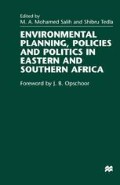Abstract
Central to most discussions on the state of the environment in Lesotho is the accelerating degradation of the productive base. For more than fifty years, land degradation and related soil erosion have been acknowledged as serious problems in Lesotho. Some important contributory factors include: (a) over-grazing of rangelands involving the selective removal of palatable climax species, leaving behind a modified habitat; (b) soil loss in the form of gully erosion and biomass removal; (c) loss of organic content and nutrient loss; (d) reduced water holding capacity and lowering of water tables; (e) general damage to soil structure and quality.
Access this chapter
Tax calculation will be finalised at checkout
Purchases are for personal use only
Preview
Unable to display preview. Download preview PDF.
References
Chakela, Q. K. (1973) “Water and Soil Resources of Lesotho (1935–1970): A Review and Bibliography”, SIES Report No. 2, Stockholm.
Chakela, Q. K. and J. Cantor (1987) History of Soil Conservation and Water Conservation Policy in Lesotho. In P. Blaikie (ed) History ofSoil Consenzztian in the SADCC Region. Soil and Water Conservation and Land Utilization Programme. Report No. 8. Maseru, Lesotho.
Germond, R. C. (1967) Ormrides ofBasutoland. Maseru, Lesotho.
Hall, D. and T. Green (1989) Conrramity Forestry in Lesotho: The People’s Perspertite Sechaba Consultants. Maseru, Lesotho.
Kumar, U. and W. Kulundu-Bitonye (1995) “An Indepth Review of Forestry Law in Lesotho”, Report Commissioned by the Lesotho National Forestry Action Programme. Ministry of Agriculture. Maseru, Lesotho.
Leslie, A. D. (1990) “Indigenous Forest and Woodland in the Kingdom of Lesotho”. Suid Afrikaanse Bosbouodyskrif No. 158.
Lesotho Energy (1988) Lesotho Energy Master Plan. Maseru, Lesotho.
Lesotho Forestry (1996) Lesotho National Forestry Action Prcgramme Lesotho National Environmental Action Plan.: Maseru: Kingdom of Lesotho
Marake, M. V. et al. (1997) “Environmental Management in Lesotho: Have the National Conservation Plans Worked”, Report submitted to (the Organization for Social Science Research in Eastern and Southern Africa OSSREA), Addis Ababa, Ethiopia.
NTIHOKI and Company: Consultants (1994) “Legal Aspects of Range Management Area/Grazing Association Programme”, Technical Reports, Ministry of Agriculture. Maseru: Kingdom of Lesotho.
Stephenson, J. G. (1988) Kingdom of Lesotho Envi rnneztal Action Plan Repart on the Consolation ofthe Fauna and Flora and Historical Relia and Monuments Components. Final Report, World Bank Consultant. Maseru: Kingdom of Lesotho
Turner, S. D. (1979) Field Realignnvrt for Conserctztiorr A Sociological Review of Expenenœ at Ratau. NUL. Roma, Lesotho.
Wenner, C. G. (1982) “Soil Conservation in Lesotho”. Draft Discussion Document. March 15.
World Bank (1987) “Lesotho: Country Economic Memorandum”, World Bank Report. No. 6671- LSO. World Bank: Washington D.C.
World Bank (1986a) Agriarkural Sector Report. World Bank and Ministry of Agriculture. Kingdom of Lesotho, Maseru.
World Bank (1986b) Lesotho Agricultural Sector Review. Eastern and Southern Africa Prot. Report No. 5866 — LSO. World Bank and Ministry of Agriculture. Kingdom of Lesotho, Maseru.
World Bank (1978) Lesotho Agricultural Sector Analysis (LASA) Team (1978) Lesotho Agriculture LASA Research Repan No. 2. Ministry of Agriculture — Lesotho and Colorado State University.
Editor information
Editors and Affiliations
Copyright information
© 1999 Organization for Social Science Research in Eastern and Southern Africa (OSSREA)
About this chapter
Cite this chapter
Marake, M.V., Molumeli, P.A. (1999). Environmental Management in Lesotho. In: Salih, M.A.M., Tedla, S. (eds) Environmental Planning, Policies and Politics in Eastern and Southern Africa. Palgrave Macmillan, London. https://doi.org/10.1007/978-1-349-27693-6_5
Download citation
DOI: https://doi.org/10.1007/978-1-349-27693-6_5
Publisher Name: Palgrave Macmillan, London
Print ISBN: 978-1-349-27695-0
Online ISBN: 978-1-349-27693-6
eBook Packages: Palgrave Political & Intern. Studies CollectionPolitical Science and International Studies (R0)

